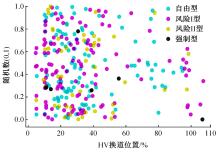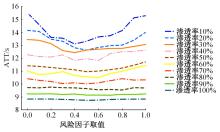Journal of Jilin University(Engineering and Technology Edition) ›› 2024, Vol. 54 ›› Issue (2): 469-477.doi: 10.13229/j.cnki.jdxbgxb.20220990
Lane⁃changing model of autonomous vehicle in weaving area of expressway in intelligent and connected mixed environment
Wei-hua ZHANG( ),Jia-ming LIU,Li-peng XIE,Heng DING(
),Jia-ming LIU,Li-peng XIE,Heng DING( )
)
- School of Automotive and Transportation Engineering,Hefei University of Technology,Hefei 230009,China
CLC Number:
- U491.2
| 1 | 曲大义,黑凯先,郭海兵,等. 车联网环境下车辆换道博弈行为及模型[J]. 吉林大学学报:工学版, 2022, 52(1): 101-109. |
| Qu Da-yi, Kai-xian Hei, Guo Hai-bing, et al. Game behavior and model of lane-changing on the internet of vehicles environment[J]. Journal of Jilin University (Engineering and Technology Edition), 2022, 52(1): 101-109. | |
| 2 | 《中国公路学报》编辑部. 中国交通工程学术研究综述·2016[J]. 中国公路学报, 2016, 29(6): 1-161. |
| Editorial Department of China Journal of Highway and Transport. Review on China's traffic engineering research progress: 2016[J]. China Journal of Highway and Transport, 2016, 29(6): 1-161. | |
| 3 | Hao W, Zhang Z, Gao Z, et al. Research on mandatory lane-changing behavior in highway weaving sections[J]. Journal of Advanced Transportation, 2020, 2020(6): 1-9. |
| 4 | 彭博, 王玉婷, 谢济铭, 等. 城市干线短交织区元胞自动机多级换道决策模型[J]. 交通运输系统工程与信息, 2020, 20(4): 41-48. |
| Peng Bo, Wang Yu-ting, Xie Ji-ming, et al. Multi-stage lane changing decision model of urban trunk road's short weaving area based on cellular automata[J]. Journal of Transportation Systems Engineering and Information Technology, 2020, 20(4): 41-48. | |
| 5 | 宗芳, 石佩鑫, 王猛, 等. 考虑前后多车的网联自动驾驶车辆混流跟驰模型[J]. 中国公路学报, 2021, 34(7): 105-117. |
| Zong Fang, Shi Pei-xin, Wang Meng, et al. Connected and automated vehicle mixed-traffic car-following model considering states of multiple front and rear vehicle[J]. China Journal of Highway and Transport, 2021, 34(7): 105-117. | |
| 6 | Dong C, Wang H, Li Y, et al. Route control strategies for autonomous vehicles exiting to off-ramps[J]. IEEE Transactions on Intelligent Transportation Systems, 2019, 21(7): 3104-3116. |
| 7 | 彭浩楠,唐明环,查奇文,等. 自动驾驶汽车双车道换道最优轨迹规划方法[J]. 吉林大学学报:工学版, 2022, 52(12): 2852-2863. |
| Peng Hao-nan, Tang Ming-huan, Zha Qi-wen, et al. Optimization based lane changing trajectory planning approach for autonomous vehicles on two lane road[J]. Journal of Jilin University (Engineering and Technology Edition), 2022, 52(12): 2852-2863. | |
| 8 | Guo J, Cheng S, Liu Y. Merging and diverging impact on mixed traffic of regular and autonomous vehicles[J]. IEEE Transactions on Intelligent Transportation Systems, 2020, 22(3): 1639-1649. |
| 9 | Treiber M, Hennecke A, Helbing D. Congested traffic states in empirical observations and microscopic simulations[J]. Physical Review E, 2000, 62(2): 1805-1824. |
| 10 | Wang H, Wang W, Chen J, et al. Using trajectory data to analyze intradriver heterogeneity in car-following[J]. Transportation Research Record Journal of the Transportation Research Board, 2010, 2188(1): 85-95. |
| 11 | 秦严严, 王昊, 王炜, 等. 混有协同自适应巡航控制车辆的异质交通流稳定性解析与基本图模型[J]. 物理学报, 2017, 66(9): 252-261. |
| Qin Yan-yan, Wang Hao, Wang Wei, et al. Stability analysis and basic graph model of heterogeneous traffic flow with cooperative adaptive cruise control vehicles[J]. Acta Physica Sinica, 2017, 66(9): 252-261. | |
| 12 | Milanés V, Shladover S E. Modeling cooperative and autonomous adaptive cruise control dynamic responses using experimental data[J]. Transportation Research Part C: Emerging Technologies, 2014, 48: 285-300. |
| 13 | Beinum A, Farah H, Wegman F, et al. Driving behaviour at motorway ramps and weaving segments based on empirical trajectory data[J]. Transportation Research Part C: Emerging Technologies, 2018, 92: 426-441. |
| 14 | Kesting A, Treiber M, Schoenhof M, et al. Adaptive cruise control design for active congestion avoidance[J]. Transportation Research Part C: Emerging Technologies, 2008, 16(6): 668-683. |
| 15 | Gipps P G. A model for the structure of lane-changing decision[J]. Transportation Research Part B: Methodological, 1986, 20(5): 403-414. |
| 16 | Yang Q, Koutsopoulos H N. A microscopic traffic simulator for evaluation of dynamic traffic management systems[J]. Transportation Research Part C: Emerging Technologies, 1996, 4(3): 113-129. |
| 17 | Minderhoud M M, Bovy P H L. Extended time-to-collision measures for road traffic safety assessment[J]. Accident Analysis & Prevention, 2001, 33(1): 89-97. |
| 18 | Li Y, Wang H, Wang W, et al. Evaluation of the impacts of cooperative adaptive cruise control on reducing rear-end collision risks on freeways[J]. Accident Analysis & Prevention, 2017, 98: 87-95. |
| 19 | Rahman M, Chowdhury S, Xie Y, et al. Review of microscopic lane-changing models and future research opportunities[J]. IEEE Transactions on Intelligent Transportation Systems, 2013, 14(4): 1942-1956. |
| 20 | Li Y, Xing L, Wang W, et al. Evaluating impacts of different longitudinal driver assistance systems on reducing multi-vehicle rear-end crashes during small-scale inclement weather[J]. Accident Analysis & Prevention, 2017, 107: 63-76. |
| [1] | Yi-gang WANG,Yu-peng WANG,Hao ZHANG,Si-an ZHAO. Identification and analysis of aerodynamic noise sources in the bogie area of high⁃speed trains [J]. Journal of Jilin University(Engineering and Technology Edition), 2024, 54(2): 346-355. |
| [2] | Cheng-ju SONG,Hong-fei JIA,Hao-fu QIN. Car following stability in mixed traffic flow with CAVs mixing [J]. Journal of Jilin University(Engineering and Technology Edition), 2024, 54(2): 419-426. |
| [3] | Hao YUE,Qi-yue ZHANG,Zi-yu YANG,Meng-jie REN,Xu ZHANG. Iterative weighted algorithms of static congestion traffic assignment considering spatial queuing [J]. Journal of Jilin University(Engineering and Technology Edition), 2024, 54(1): 136-145. |
| [4] | Xing WEI,Ya-jie GAO,Zhi-rui KANG,Yu-chen LIU,Jun-ming ZHAO,Lin XIAO. Numerical simulation of residual stress field of stud girth weld in low temperature environment [J]. Journal of Jilin University(Engineering and Technology Edition), 2024, 54(1): 198-208. |
| [5] | Xiao-jing DU,Rong-han YAO. Evolutionary game mechanism of mandatory lane changing for exiting for intelligent connected bus [J]. Journal of Jilin University(Engineering and Technology Edition), 2024, 54(1): 124-135. |
| [6] | Zhi ZHENG,Pei YUAN,Xuan-hui JIN,Si-si WEI,Bo GENG. Experimental on composite flexible anti⁃collision fender of bridge pier [J]. Journal of Jilin University(Engineering and Technology Edition), 2023, 53(9): 2581-2590. |
| [7] | Zhuang-lin MA,Shan-shan CUI,Da-wei HU,Jin WANG. Travel mode choice of traditional car travelers after implementation of driving restriction policy [J]. Journal of Jilin University(Engineering and Technology Edition), 2023, 53(7): 1981-1993. |
| [8] | Chao-ying YIN,Ying LU,Chun-fu SHAO,Jian-xiao MA,De-jie XU. Impacts of built environment on commuting mode choice considering spatial autocorrelation [J]. Journal of Jilin University(Engineering and Technology Edition), 2023, 53(7): 1994-2000. |
| [9] | Ya-li ZHANG,Rui FU,Wei YUAN,Ying-shi GUO. Classification and recognition model of entering and leaving stops' driving style considering energy consumption [J]. Journal of Jilin University(Engineering and Technology Edition), 2023, 53(7): 2029-2042. |
| [10] | Chun-li WU,Shi-ming HUANG,Kui LI,Zheng-wei GU,Xiao-ming HUANG,Bing-tao ZHANG,Run-chao YANG. Analysis of pier action effect under flood based on numerical simulation and statistical analysis [J]. Journal of Jilin University(Engineering and Technology Edition), 2023, 53(6): 1612-1620. |
| [11] | Zheng-wei GU,Pan ZHANG,Dong-ye LYU,Chun-li WU,Zhong YANG,Guo-jin TAN,Xiao-ming HUANG. Earthquake⁃induced residual displacement analysis of simply supported beam bridge based on numerical simulation [J]. Journal of Jilin University(Engineering and Technology Edition), 2023, 53(6): 1711-1718. |
| [12] | Feng WANG,Shuang-rui LIU,Jia-ying WANG,Jia-ling SONG,Jun WANG,Jiu-peng ZHANG,Xiao-ming HUANG. Size and shape effects of wind drag coefficients for porous structures [J]. Journal of Jilin University(Engineering and Technology Edition), 2023, 53(6): 1677-1685. |
| [13] | Heng-yan PAN,Yong-gang WANG,De-lin LI,Jun-xian CHEN,Jie SONG,Yu-quan YANG. Evaluating and forecasting rear⁃end collision risk of long longitudinal gradient roadway via traffic conflict [J]. Journal of Jilin University(Engineering and Technology Edition), 2023, 53(5): 1355-1363. |
| [14] | Hai-bin WEI,Shuan-ye HAN,Hai-peng BI,Qiong-hui LIU,Zi-peng MA. Intelligent sensing road active ice and snow removal system and experimental technology [J]. Journal of Jilin University(Engineering and Technology Edition), 2023, 53(5): 1411-1417. |
| [15] | Jing-fu JIN,Xin-ju DONG,Zhi-cheng JIA,Kang WANG,Lian-bin HE,Meng ZOU,Ying-chun QI. Optimization of the tread plate-spring structure of flexible metal wheel with plate-spring [J]. Journal of Jilin University(Engineering and Technology Edition), 2023, 53(4): 964-972. |
|
||













